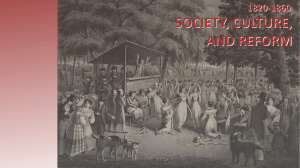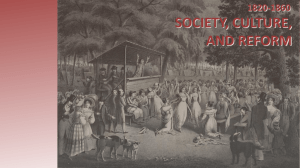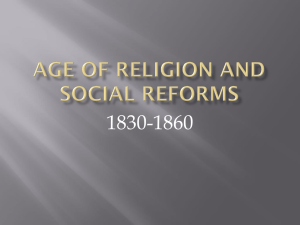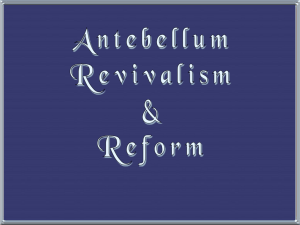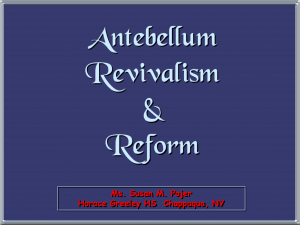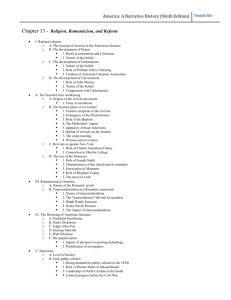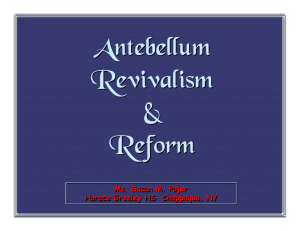LECTURE 04_The Reform Era
advertisement
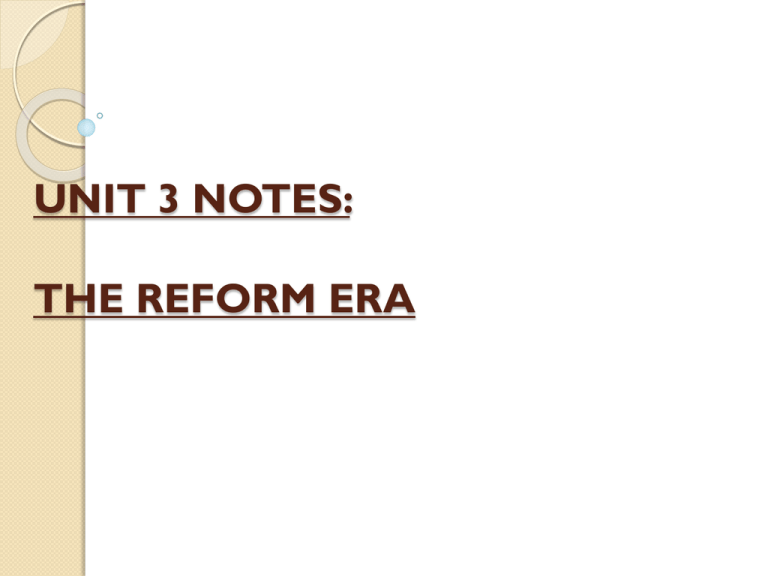
UNIT 3 NOTES: THE REFORM ERA EDUCATION REFORM EARLY SCHOOLS Early Characteristics ◦ ◦ ◦ ◦ One room, one stove, one teacher Up to grade 8 Stayed open only a few months a year Blacks in the South were legally forbidden to receive instruction in reading and writing School teachers were ill-trained, ill-tempered, ill-paid men ◦ Often put more stress on “lickin” of discipline then “larnin” ◦ Taught the 3 R’s Readin’, ritin’, and rithmetic ◦ Reform was desperately needed Whigs were reformers who created the most advanced, expensive, centralized state school systems ◦ Talked more about schools teaching character development ◦ It was school’s first duty to teach youngsters to respect authority, property, hard work, and social order ◦ Schools would downplay class divisions, democratize the wealthy, civilize the poor TAX SUPPORTED EDUCATION Tax supported schools were scarce in the early years of the republic ◦ They existed chiefly to educate the children of the poor – the socalled ragged schools ◦ In mid-1800s local and state governments built tax supported public school systems known as “common schools” Before this time children learned reading, writing, and arithmetic at home, in poor local schools, private schools, or church sponsored schools By 1830 Whigs and democrats agreed the providing common schools was a proper function of government ◦ Both agreed that schools could equalize opportunity for both rich and poor ◦ Well-to-do conservatives realized that if they did not pay to educate other “brats”, those brats would grow up armed with voting power McGuffy Readers In 1833, a small publishing company called Truman and Smith based in Cincinnati, Ohio, became interested in the idea of school texts. They happened upon Rev. William Holmes McGuffey. ◦ This first reader of 1841 introduces children to McGuffey's ethical code. ◦ The child modeled in this book is prompt, good, kind, honest and truthful. The second reader followed the same pattern. ◦ It contained reading and spelling with eighty-five lessons, sixteen pictures and one-hundred sixty-six pages. ◦ It outlined history, biology, astronomy, zoology, botany; table manners, behavior towards family, attitudes toward God and teachers, the poor Millions of pioneer men and women were schooled with these texts REFORM LEADERS Horace Mann (1796 – 1859) ◦ Graduated from Brown University ◦ As Secretary of Mass. Board of Education he campaigned for better schoolhouses, higher pay for teachers, expanded curriculum Noah Webster (1758 – 1843) ◦ Yale educated ◦ Known as “Schoolmaster of the Republic” ◦ His reading lessons were used by millions of children in the 1800’s ◦ Lessons often designed to promote patriotism ◦ Devoted 20 years to his dictionary (1828) which helped standardize the American language The movement for women’s rights The Movement for Women’s Rights Main Idea: Although women were expected to devote their time to home and family in the 1800s, some women organized the women’s rights movement in the 1840s Limits for Women Industrialization had a large impact on women’s roles ◦ Women in more comfortable households were freed from chores such as growing their own food and making clothes ◦ The Industrial period made it so more timesaving products were available With this free time, most believed women should remain in the home ◦ The ideal of the stay-at-home woman that was expected to raise the children, entertain guests, and serve their husbands was called the Cult of True Domesticity (or True Womanhood) ◦ Women could not vote, could not own property, and most had to turn wages over to a husband or father Reform at Home Many women were not lobbying for political rights, they instead advised women to reform society from within their roles in the home ◦ Catherine Beecher tried to win respect for women’s contributions as wives, mother’s, and teachers ◦ She lobbied for the education of women ◦ Felt that women were the moral background of the country Women in Reform As more women became educated, they grew eager to apply their knowledge beyond the home ◦ Women played a prominent role in every type of reform, from temperance to abolition ◦ They marched in parades, participated in boycotts, and even gave speeches A Women’s Rights Movement Lucretia Mott ◦ ◦ ◦ ◦ B. 1793 Teacher Became a Quaker minister Was also an abolitionist Elizabeth Cady Stanton ◦ Daughter of a Congressman ◦ Studied law ◦ Married an abolitionist lawyer Both were angered when they were not allowed to participate in the 1840 World Anti-Slavery Convention in London Seneca Falls Convention Took place in Seneca Falls, NY ◦ July 1848 ◦ First women’s rights convention in U.S. history Created a document titled the “Declaration of Sentiments” ◦ In the spirit of the Declaration of Independence ◦ Passed 12 resolutions signed by 68 women and 32 men ◦ Resolutions protested lack of political rights for women ◦ The 9th resolution called for women’s suffrage Effects The convention did not trigger wide spread change ◦ Many shared Catharine Beecher’s view of women’s influence being through the home ◦ Yet it did mark the beginning of an organized movement for women’s rights Impact on Education: No college admitted women in 1820 – thousands were graduating from colleges in 1890 People to Know Sojourner Truth Catharine Beecher Lucrettia Mott Elizabeth Cady Stanton Sojourner Truth http://www.youtube.com/watch?v=EsjdLL 3MrKk 1851 Speech by abolitionist, women’s rights activist, poet, and writer – Sojourner Truth The TEMPERANCE MOVEMENT The temperance movement The first and most widespread reform was the temperance movement ◦ This was an organized campaign to eliminate alcohol consumption ◦ In the early 1800s America consumed more alcoholic beverages per person than at any other time in our nation’s history Reformers opposed drinking because it tended to make people lose control and was viewed as a threat to family life PROBLEMS WITH ALCOHOL Central to the party formation in the north were the evangelical Whigs who demanded that government regulate public social behavior Central to this fight was the issue of alcohol drinking had been a part of American life since colonial times withering authority and the market revolution had led to increased public drunkenness and a perceived increase in alcohol led violence and social problems Heavy drinking decreased efficiency of labor It also fouled the sanctity of family and threatened spiritual welfare GOALS Two plans of attack: ◦ Stiffen individual will to resist alcohol ◦ Eliminate alcohol by law By encouraging total abstinence, reformers hoped to halt the creation of a wave of new drunkards ◦ While abstinence relies on self discipline the hope was to fade alcohol out through social pressure and expectations ◦ Many churches made temperance a condition of religious conversion or jobs as a condition of employment REORMERS Lyman Beecher ◦ Temperance core beliefs were based on writings from Lyman Beecher’s Six Sermons on the Nature, Occasions, Signs, Evils, and Remedy of Intemperance (1826) ◦ Beecher declared alcohol an addictive drug T.S. Arthur ◦ Novel: Ten Nights in a Barroom and What I Saw There (1854) ◦ Described a once happy village ruined by Sam Slade’s tavern American Temperance Society ◦ The temperance crusade began in 1826 when northeastern evangelicals founded the American Society for the Promotion of Temperance, or American Temperance Society ◦ They implored drinkers to sign temperance pledges, handed out brochures and pamphlets, and lectures ◦ Between 1815 and 1840 thousands of temperance societies formed ◦ Members urged people to take pledges not to drink alcohol Efforts against alcohol In the mid 1830s Whigs made temperance a political issue ◦ They realized voluntary abstinence would not put an end to drunkenness ◦ They first attacked licenses granting establishments rights to sell it ◦ The goal was to outlaw all public drinking places Neal Dow of Main “Father of Prohibition” ◦ sponsored the Main Law of 1851 which banned the sale of alcohol ◦ This attempt proved feeble as taverns would operate anyways or would find ways around laws ◦ 1838 Massachusetts Fifteen Gallon Law Democrats agreed that Americans drank too much, they warned that government intrusion into areas of private choice violated republican liberties ◦ Eventually prohibition laws were abolished ◦ The temperance movement did have a significant effect: ◦ Between 1830 and 1860 alcohol consumption in the U.S. dropped dramatically The anti-slavery movement The abolitionist movement Another social movement began to gain momentum: abolition The abolitionist movement was an effort to end slavery Even during colonial times there were people outspoken against slavery but it in the early 1800s it became widespread At first, most anti-slavery approaches were moderate ◦ ◦ ◦ ◦ Quaker Ben Lundy proposed gradual emancipation in 1821 Emancipation is the freeing of slaves He favored stopping slavery from being used in new states Wanted to end slave trade in the U.S. as a gradual step By the end of the 1820s, free African-Americans had created over 50 anti-slavery groups American colonization society Some abolitionists favored colonization ◦ Many were convinced that African Americans would never receive equal treatment in American society ◦ Colonization favored a plan to send emancipated slaves and free African Americans to form new societies in Africa The American Colonization Society formed in 1817 ◦ They established the west African country of Liberia for this purpose ◦ This plan offended many African Americans as they considered themselves Americans and did not want to be sent to a far away country William lloyd garrison Famous, radical abolitionist White Bostonian In 1831 he began publishing an antislavery newspaper, The Liberator Frederick Douglass One of the most popular and influential speaker in the anti-slavery movement was Frederick Douglass ◦ He was an accomplished writer, publisher, and speaker ◦ He was the son of a white father and slave mother ◦ He was raised by his grandmother and at age 8 was sent to Baltimore to be a house slave ◦ His owners ignored common law at the time and educated him At age 17 he was considered unruly and was sent to a “slave breaker” to become cooperative ◦ He later defended himself against the breaker and later said it was the story of “how a man became a slave and a slave became a man” In 1838, at age 21 he disguised himself as a sailor and escaped to Massachusetts ◦ After rousing speeches he soon became leader of the American Anti-Slavery Society He started an abolitionists newspaper called the North Star Throughout his life he became a important influence in the abolitionist movement Frederick Douglass http://www.youtube.com/watch?v=7j0jvj4 e4XU&feature=relmfu Divisions among abolitionists While abolitionists shared a common goal, they had different tactics to achieve those goals These different ideas cause divisions in the movement Women’s Participation ◦ Many Americans did not approve of women’s involvement in politics Race ◦ Many African Americans felt that white abolitionists treated them as inferior Tactics ◦ Some insisted on only legal methods ◦ Many believed legal methods were too long-term The underground railroad With tremendous human suffering, many would not wait for long-term strategies to work Risking arrest and their lives, abolitionists created the Underground Railroad This was a network of escape routes that provided protection for slaves escaping to the north Historians disagree on the number, but somewhere between 50,000 and 100,000 slaves escaped on these routes They traveled along rivers routes, through eastern swamps, along mountain passes Resistance to abolition These abolition movements provoked intense opposition in the North and South ◦ Most white Americans viewed abolition as a radical idea ◦ Northern merchants worried that the anti-slavery movement would hurt business from southern customers ◦ White workers feared that freed slaves would take their jobs by working for lower wages Even though many thought slavery was wrong, most northerners felt African Americans were socially inferior and did not want them living in their communities These movements made southerners even more determined to defend slavery ◦ In 1830s it became dangerous for a southerner to speak out against slavery ◦ Southern postmasters refused to deliver literature about abolition Southern Congressmen succeeded in passing what many called a Gag Rule ◦ It prohibited anti-slavery petitions from being read or acted upon in the House for 8 years FEMALE ABOLITIONISTS Harriet Tubman Sojourner Truth Harriet Tubman http://www.youtube.com/watch?v=Bdno2 YLm4Ms
